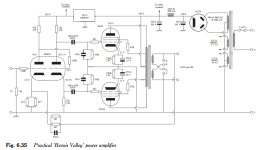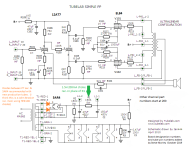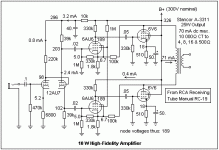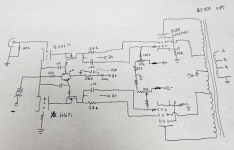The basic circuit & patents reference.🙂
Additional an article from a Philips Technical Review from 1957 in which this form of positive feedback combined with more negative feedback is described:
Attachments
The Z565 overview on Triode Electronics site suggested "a healthy inductance over 1000."
That was a typo on the triodeel site, for sure. It's 100H (two zeroes, not three).
Still, that's an excellent OPT, if it's still available...
I have the transformers from an ST35 I bought in the late 1980s ($40 USD for that and a PAS2 preamp, together). The downside of the vintage iron is that it only has 8 ohm and 16 ohm secondary taps. I'd much prefer to have a 4 ohm tap. The new, repro one has 4 ohms and 8 ohms, much better with contemporary speakers.
Last edited:
The OP is probably wondering what happened to his thread.
jeff
No problem! 😀
If the discussion is helpful to anyone, that is good.
If the question was, "Which push-pull EL84 amp design should I build?" then I think it's all at least somewhat relevant. Right?
Definitely relevant. I was just thinking that maybe it was getting a little bit too much for the OP, and he had just tuned out. I've seen this happen before.😉
jeff
jeff
If the question was, "Which push-pull EL84 amp design should I build?" then I think it's all at least somewhat relevant. Right?
Agreed.
As was once thrown at me on this site: take note of the heading: Projects by Fanatics - For Fanatics".
Since many of the subjects tend to go on forever, and discussions/opinions are widely spread, I see no reason to contain things if they're part of the deal. 😉
To higher my "on topic / off topic" ratio a bit: http://www.introni.it/pdf/Rodenhuis%20-%20HiFi%20Circuits.pdf
- On pages 42 to 53 two variants (depending on the specs of the OPT) of an amplifier with EF86 + ECC83 + 2 x EL84 pp + EZ81.
- On pages 67 to 73 an amplifier with ECC83 + 4 x EL84 pp + GZ34 in which both positive and (more) negative feedback is applied.
- On pages 42 to 53 two variants (depending on the specs of the OPT) of an amplifier with EF86 + ECC83 + 2 x EL84 pp + EZ81.
- On pages 67 to 73 an amplifier with ECC83 + 4 x EL84 pp + GZ34 in which both positive and (more) negative feedback is applied.
Last edited:
This is a good one
I just finished this old RCA design. Exchanged the 12au7 at the front for the Russian 6n16b (cathode resistor 4K7). Used a mosfet regulator.
Sounds incredibly good with a 60 year old OPT..
I believe you can use the EL84 instead of the 6V6 if you want.
I just finished this old RCA design. Exchanged the 12au7 at the front for the Russian 6n16b (cathode resistor 4K7). Used a mosfet regulator.
Sounds incredibly good with a 60 year old OPT..
I believe you can use the EL84 instead of the 6V6 if you want.
Attachments
I'm rebuilding a Leak Stereo 20 and wondering which circuit to choose. I'm most tempted by a concertina first stage like Tubelab and Bevois Valley. See post #20. I don't really want to add a negative voltage source for a LTP.
I'd prefer to use an ECC40 in the input stage and would adjust the operating point accordingly.
I'd prefer to use an ECC40 in the input stage and would adjust the operating point accordingly.
Last edited:
Please keep us informed of your thinking and progress. Are you planning to use GNF? If so I wondered it the 25x gain of the ECC40 would be sufficient.
I also have an interest in trying an ECC40 in this manner to drive an EL84 output stage.
I also have an interest in trying an ECC40 in this manner to drive an EL84 output stage.
Here's another fully documented classic along those lines. Maybe this is a silly question, but why not build the Leak Stereo 20 circuit?I'm rebuilding a Leak Stereo 20 and wondering which circuit to choose.
Attachments
Hello Francois. So you're another fan of the ECC40? Excellent.Please keep us informed of your thinking and progress. Are you planning to use GNF? If so I wondered it the 25x gain of the ECC40 would be sufficient.
I also have an interest in trying an ECC40 in this manner to drive an EL84 output stage.
My first thought was a triode amp with no GNF. So I was planning a type 37 front end and a mosfet splitter. That would still work and be better still with a 27 mesh plate, which would require an extra 2.5V transformer. An alternative would be a 6AH4 which I've used before and sounds good.
In answer to Merlin - I wanted something better than the Leak circuit. If I stayed with triode mode I could use e.g. a 6N30P in concertina though I'm not a big fan of that tube. Since I do like the ECC40 I'm thinking to use ultralinear with a bit of GNF to get more output.
Still up in the air about this build.
I’m not a fan with ECC40 experience yet, but I have collected a few NOS ECC40s and recently bought some matching NOS McMurdo B8a sockets. So, now I am in business to try it out. I thought I would try the Voltage amplifier/splitter in figure 6 of the Philips data sheets as a starting point, but I will watch your progress closely.
https://frank.pocnet.net/sheets/046/e/ECC40.pdf
https://frank.pocnet.net/sheets/046/e/ECC40.pdf
I took this sort of thing on recently. Used for my build Sherwood S5000 OPT's. They have 28% U-L. I used 6P15P-EV finals. Power supply is a 300V plus heaters SMPS from Ali that I got for about $35 delivered. Schematic is below. Mostly complete... 🙂
Douglas
Douglas
Attachments
I made this, it seems to be good
Walter
Hello!
This is the last circuit I have developped around a push-pull of EL84.
The intention was to make a simply solution with a very good OT trafo.
In attach the schematic: it use a 6922 with the first section at gain and the second as cathodyna.
Then the output stage with fixed bias and a pentode connection ( my preferred).
The OT trafo is a double C core, laminated 0,1 mm, with 39:1 ratio.
The secondary is one fixed at 6 ohm nominal; the ratio is very high this because the intention was to fix the bias point in full class A until the max power.
The second image is the proto of the OT...
This is the last circuit I have developped around a push-pull of EL84.
The intention was to make a simply solution with a very good OT trafo.
In attach the schematic: it use a 6922 with the first section at gain and the second as cathodyna.
Then the output stage with fixed bias and a pentode connection ( my preferred).
The OT trafo is a double C core, laminated 0,1 mm, with 39:1 ratio.
The secondary is one fixed at 6 ohm nominal; the ratio is very high this because the intention was to fix the bias point in full class A until the max power.
The second image is the proto of the OT...
- waltube
- Replies: 46
- Forum: Tubes / Valves
Walter
Don’t forget the amp from which the Baby Huey is derived: http://www.dissident-audio.com/PP_ECL86/Page.html
ECL86 is just half 12AX7 and one EL84 in one single envelope.
ECL86 is just half 12AX7 and one EL84 in one single envelope.
The pentode (or better: beam tetrode) section of the ECL86 has a maximum anode dissipation of 9 Watt against 12 Watt for the EL84. And there are more differences between the two.
The characteristics of the pentode section of the ECL86 are almost identical to those of the EL41.
The characteristics of the pentode section of the ECL86 are almost identical to those of the EL41.
You are right Robert. What I meant is that they are similar enough to be used in that circuit.ECL86 has a maximum anode dissipation of 9 Watt against 12 Watt for the EL84
Me and others did exactly that and it is pleasant sounding in its simplicity.
I have a question about the input valve for an EL84 PP amp in UL mode. I want to use a voltage stage coupled to a concertina, like the Bevois Valley or Tubelab circuits. The Bevois uses an E88CC, the Tubelab a 12AT7. Gains of 33 and 60 respectively. I've considered using a 6SN7 with gain of 20. A better valve in itself than the other two. But how would the GNF loop work with a valve of lesser gain?
What would be the pros and cons of using a 6SN7 in the first stage?


What would be the pros and cons of using a 6SN7 in the first stage?


- Home
- Amplifiers
- Tubes / Valves
- Recommendations for PP EL84 circuits

